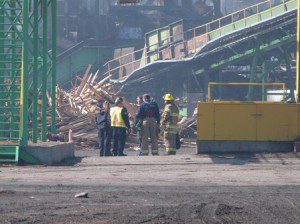 A B.C. safety agency has urged changes for sawmill owners and to the fire and electrical codes in an effort to mitigate the risks posed by explosive levels of wood dust and to avoid the kind of explosion that killed two mill workers last year.
A B.C. safety agency has urged changes for sawmill owners and to the fire and electrical codes in an effort to mitigate the risks posed by explosive levels of wood dust and to avoid the kind of explosion that killed two mill workers last year.
The BC Safety Authority, which oversees the safe installation and operation of equipment and administers B.C.’s Safety Standards Act, made nine recommendations in a report Tuesday about wood dust.
They include recommending that the Canadian Standards Association classify wood dust as combustible, with improvements to the requirements around natural gas and propane codes.
“Wood dust can have explosion and fire hazard characteristics similar to other known dusts that are identified as combustible dusts in the Canadian Electrical Code,” the report said.
The report noted the U.S. Occupational Safety and Health Administration has classified fine wood dust as having “strong explosion” characteristics.
“Wood dust and potential ignition sources exposed to wood dust are required to be managed. Locations where wood dust accumulates or is suspended in atmosphere are considered hazardous locations.”
The BC Safety Authority investigation followed an explosion and fire last year that killed two sawmill workers and injured 20 others at Babine Forest Products on Jan. 20, 2012 near Burns Lake, in B.C.’s north-central Nechako region.
The tragedy — the first of two fatal mill explosions in 2012 — destroyed the Babine mill and killed employees Robert Luggie, 45, and Carl Charlie, 42.
An investigation already conducted by WorkSafe BC blamed the incident on dry wood dust, which had accumulated from pine-beetle killed wood and was ignited by machine parts.
“Our aim was to conduct a thorough investigation and learn all we could to prevent the recurrence of similar incidents,” Greg Paddon, the group’s director of technical programs, said in a media release.
“Now we can use that knowledge to initiate improvements toward the management of safety risks.”
For mill operators, the authority recommended qualified professionals should identify areas in sawmills with dust hazards that could catch fire, and mills should develop better ways to manage that dust.
The fire commissioner should publish a list of qualifications professionals must meet if they want to identify wood dust and explosion hazards, states the report.
The report’s recommendations are directed at mill owners and operators, the Office of the Fire Commissioner in B.C., as well as the Canadian Standards Association.
Babine Forest Products said in a media release it hasn’t analyzed the report, but the safety agency’s work will ensure sawmills are safer in the future.
At the time of the blast, it added, the company had equipment designed to reduce wood dust, but “the scope of the hazard was not fully understood.”
The new mill, announced in early December, will include ( continue reading … )
Source: Vancouver Sun
Discussion
No comments yet.